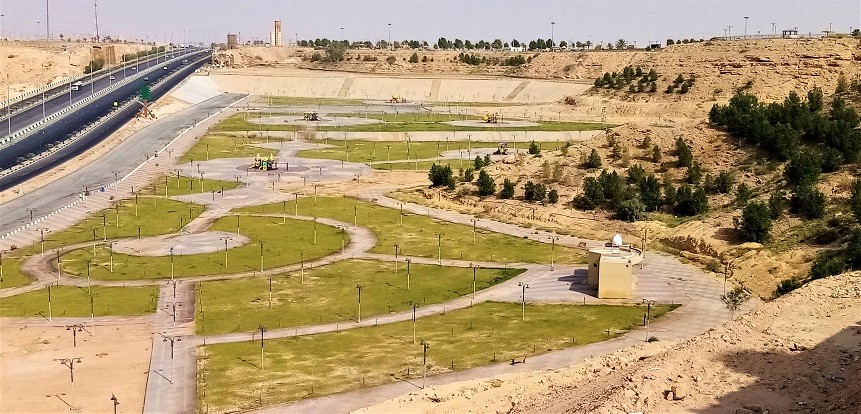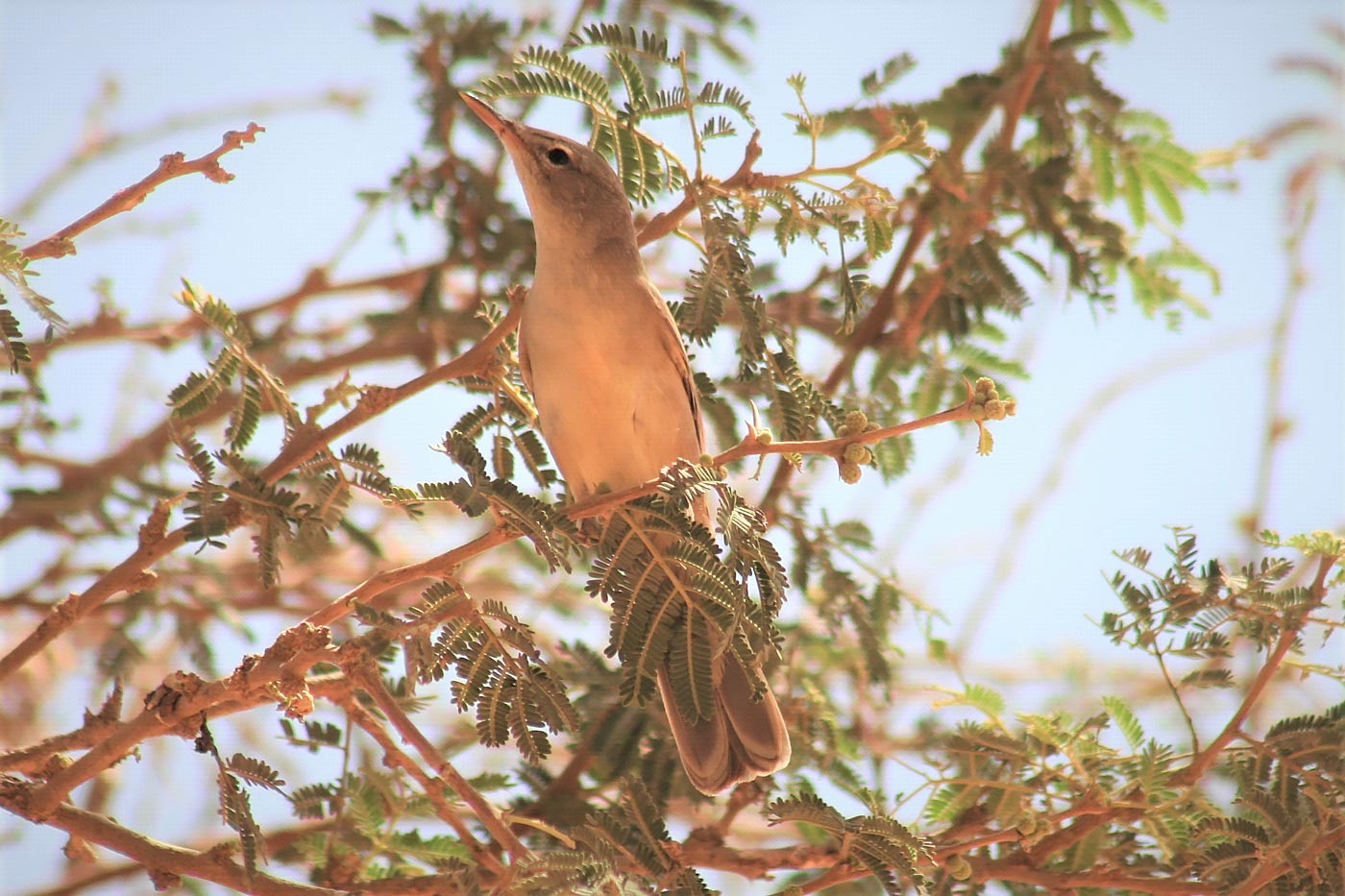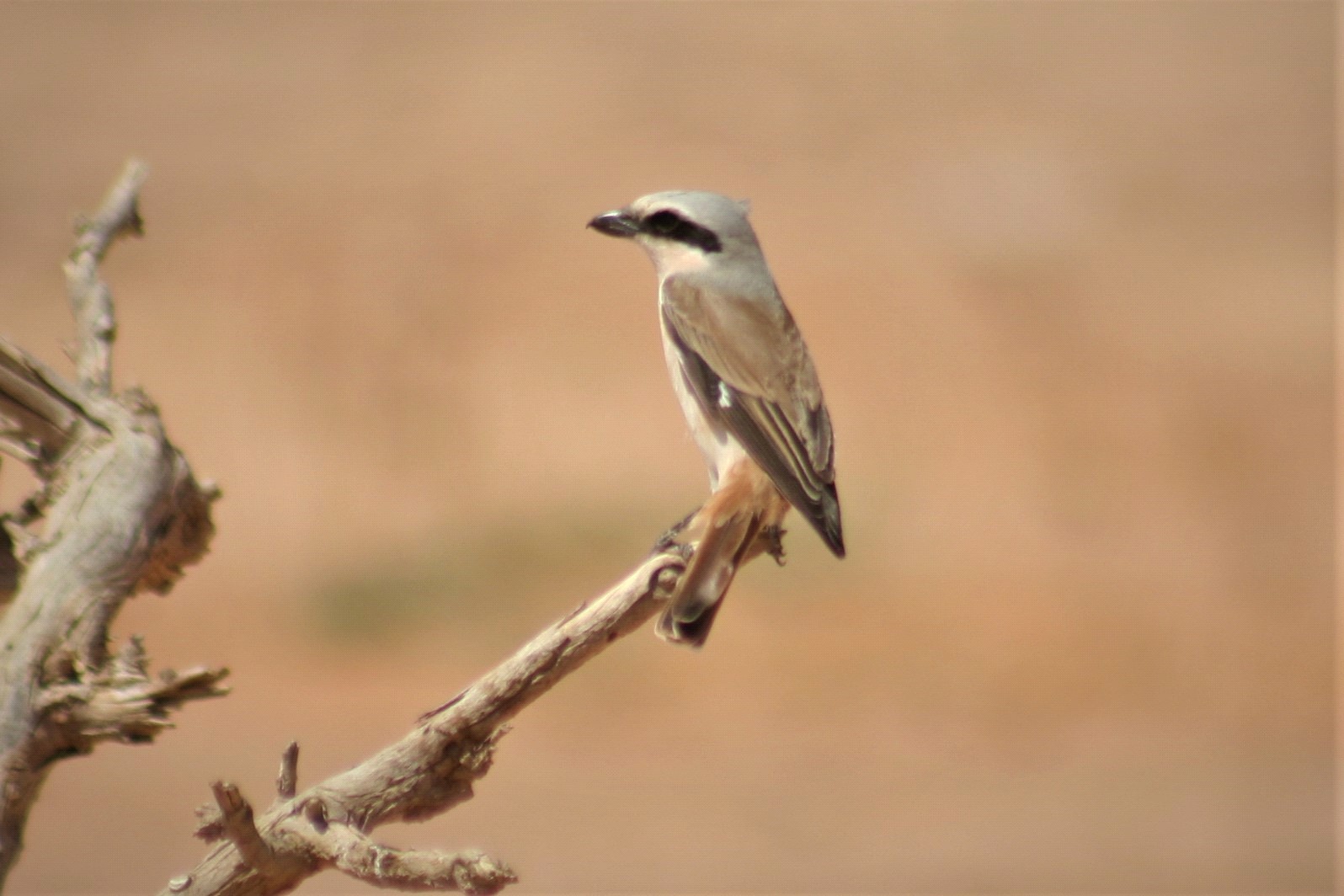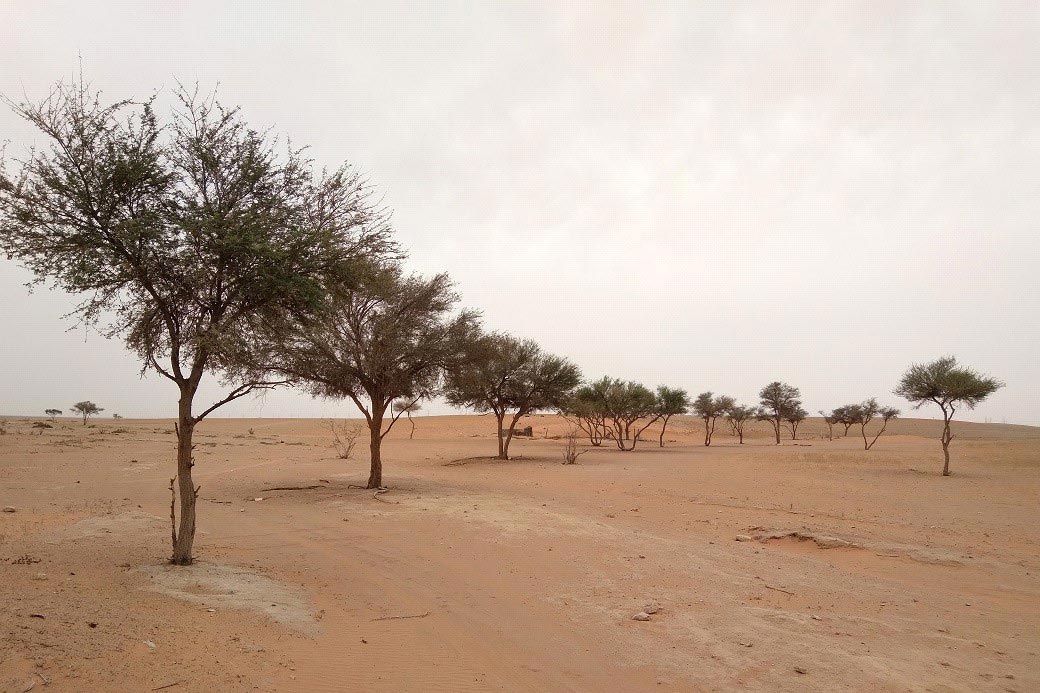Continued from part one.
If I felt like fortune had blessed me in terms of the work environment that I had to look forward to each day during my six weeks in Saudi Arabia this spring, how did I feel about the town I was located in where I got to spend my evenings and my days off?
Just like my survey site in the desert, the nearby town I was housed in was a completely unknown entity, with no previous birding activities in the area that I knew of. I figured the very central location within the country wouldn't help me in terms of seeing any migration spectacles and reasoned that if I set my ambitions at winkling out just one each of Upcher's Warbler, White-throated Robin and Rufous-tailed Scrub Robin in the time I was there (the first two of which would be completely new birds for me, the last one I hadn't seen in nigh-on 30 years), I'd consider that a reasonable success. Realistically however, I was mentally preparing myself to be reading the back of shampoo bottles for entertainment by the end.
My first real-time view of the neighbourhood over the first couple of days didn't really alter my view that the birding was likely to be sparse and that rewards would have to be patiently accrued over time. As I set off in the half-light towards work for the first couple of mornings along a wide three-lane highway flanked by dozens of fast food outlets, I saw little other than a few unassuming areas of manicured shrubbery and scattered shade laurel trees. There seemed to be an inordinate number of swings and kids' playgrounds considering the very few children I saw around – indeed the very few people I saw walking around in general, this being very much a car culture reminiscent of a brief visit of mine to Los Angeles many years ago!

A view of the town from a nearby hilltop, showcasing 'Subway Park'.
The first day's break from official duties quickly revealed how inaccurate my initial reading of the place had been from a birding standpoint. As soon as I crossed into the first bit of green from the apartment at first light, I was amazed to find a dozen Common Chiffchaffs and several Reed Warblers feeding right out in the open, on the grass in what was basically part of the main street. Pretty soon the number of Isabelline, Masked and Woodchat Shrikes on display overtook the handful I'd seen in the desert wadis, and once I'd seen a couple of Black Scrub Robins flaunting themselves on the lawns, and a few Great Reed and Eastern Orphean Warblers among the shrubbery, it suddenly appeared I might have stumbled into a good thing.
There were two distinct parts to what was to become my local patch for the following 45 days – closest to home being what I called 'Subway Park', where I'd sat eating a sandwich from the franchise of the same name with my two colleagues on my very first evening in town. A little further away, across 500 m of sun-baked concrete, was a much more open arena – a spot I went on to find out was even less regularly visited by the general public than Subway Park, despite being twice the size and home to half-a-dozen of the ubiquitous children's play areas. This place I ended up calling 'Lookout Park' in correspondence to friends, because it lay beneath an elevated viewpoint that formed the eastern gateway to the town. As well as the largely unused slides and climbing frames, this site was particularly notable for what were literally hundreds of lampposts standing virtually on top of each other, illuminating at night an extensive area of grassy patches that seemed to be watered daily by an elaborate system of somewhat leaky pipes and sprinklers.

The more open 'Lookout Park' on the outskirts of town. Check out all those lampposts!
It was here, on that initial Friday morning, that the first in a series of any number of notable 'wow' moments occurred. I've done my share of birding for Palearctic migrants in Bangkok's city parks over the past decade – a whole other story, but I mention it here because those parks are attractive and worth a visit whether you're looking for birds or not. This place certainly wasn't that. But it did bring almost instant unexpected reward in the shape of two lifers – a jittery flock of 40 Grey Hypocolius (a uniquely attractive, very localised species I thought would be much further north on its Iraqi breeding grounds by now) and an Upcher's Warbler, a bird I've waited to see since first reading about it in British Birds back in the mid-1980s.

An Upcher's Warbler with its big, wide dark tail, constantly waggled.
For the time being my first view of that initial Upcher's Warbler was something more of an appetiser than a main course. The most stunning moment of the morning came around 10 am, just as I was thinking about retreating indoors for some respite from the heat. All of a sudden, a male Common Rock Thrush flopped lazily over my head and landed on a lamppost right up above me; sitting there in the blazing sunshine for 10 minutes before dropping to the floor, picking up an insect, and flying loosely to sit atop the next lamppost in the row. This beautiful moment with a bird I'd always thought of as a shy and wary inhabitant of wild, rocky places, in a totally bland-looking, human-designed, suburban park, was the true harbinger of what I would go on to experience over the coming weeks. The very next weekend, that same moment was to repeat itself in a very similar way when my first-ever White-throated Robin, also a male, materialised in much the exact same spot, in full view in perfect early morning sunshine, and went about its business as though it was the most natural thing in the world for it to be there. Which, as I was in the process of discovering, it probably was.

Male White-throated Robin (Paul Cook).
For the first month of the official survey, I was working long days and only occasionally managed to get an hour at Subway Park at last light to be afforded tantalising glimpses of what I might have seen had I been able to spend all day there. When Ramadan commenced around the second week of April, my work schedule switched to shorter days, allowing me to spend a few early mornings and some longer afternoons in the park during the week.
Apart from a couple of back-to-back grey days in early April, the weather during the period I was in Saudi varied little at all. There was never a time I could forecast a likely fall of birds from the sky. Indeed, numbers of migrants remained consistently high on most days; genuinely quiet days were virtually non-existent, and new arrivals could be expected at almost any time. As a long-term voyeur of seasonal bird migration, it was inevitable I would attempt to make comparisons with other areas I'd been situated for lengthy periods and felt free to make my own best-guess speculations as to what strategies the birds were employing to get there.
I suspected the vast majority of birds turned up in the two hours before dawn, but it was a suspicion without proof – there was no vocal component to the nocturnal migration like I experienced with North American songbirds in Cape May. In the end, I couldn't help but get caught up in the actual spectacle of the event and spent increasingly less time trying to work out the whys and the wherefores. For someone who's been told he spends too much time obsessing about weather events, bird migration and species vagrancy in the British Isles, it was actually quite freeing to be reminded of how nice it is just to witness 'normal' migration as it is ideally meant to be when the weather is consistently fine.
In between the rock thrush and the White-throated Robin moments, my first Rufous-tailed Scrub Robin of the trip had the same “Boom, there it is!” appeal about it. No wind, no rain, no tantalising half-glimpses of a shadowy, skulky form, just there in full view, metres away, on the park lawn, feeding in its own inimitable manner with tail cocked, wings spread out in a Black Heron-like umbrella posture, chasing insects across the grass.

A confiding Rufous-tailed Scrub Robin in one of the desert wadis. Those in the parks were equally approachable.
Not only did I totally underestimate the numbers of certain species I was later destined to see, there were other forecasts made that I was later pleased to have been proven wrong about, too. I was rather expecting most of the total migration of all species to have faded away by the time I left Saudi Arabia and was preparing myself mentally for perhaps a tough final fortnight in increasingly high temperatures as I began to cast my thoughts towards a return to leafy England. This was far from the reality that transpired.
Instead, what actually happened was that this whole remarkable escapade reached a magnificent crescendo across both desert and town parks simultaneously, culminating in some of the most intense days of spring bird migration I've witnessed outside the Great Lakes region of North America. It was Red-backed Shrikes, primarily, that led the spectacle from around 20 April. Ten in a morning out in the desert acacias became 40 in a day, with an afternoon stroll to Lookout Park watching them dropping from the lampposts on to the grass to feed in competition with the Lesser Grey Shrikes – themselves having suddenly gone from zero to five or six in a day, every day. With the Turkestans and Isabellines that had never really gone away and just kept going and going and going ...

Male Red-backed Shrike. Somewhere between 200 and 300 were seen in total (Paul Cook).

Among the hundreds of shrikes Graham saw, three apparent hybrid Red-backed × Turkestan Shrikes were picked out – including the one pictured above.
As previously intimated, Upcher's Warbler's became increasingly numerous out in the acacias, while Barred, Eastern Olivaceous and Great Reed Warblers increased daily in the parks. It was very nice, I have to say, for a UK birder like myself who was enjoying so many Middle Eastern specialities, to see familiar old friends like Common Chiffchaff, Willow Warbler and Common Whitethroat moving through in fair numbers in unfamiliar settings. Spotted Flycatchers, Whinchats and Common Redstarts all had a moment in the final fortnight when they were among the top three most numerous migrants of the day.

At the end of April this one set of trees held: four Red-backed, one Lesser Grey and one Isabelline Shrike; Upcher's Warbler, six Willow Warblers, three Common Whitethroats, male Common Rock Thrush, Rufous-tailed Scrub Robin, female White-throated Robin and a Common Redstart.
In mid-April I discovered a thin strip of overgrown reedy ditch behind the gas station that separated the two parks I frequented, and it was here I had my only Bluethroat and Citrine Wagtail of the spring, and quite regular, frustrating glimpses of Wood Sandpiper and Little Stint. It was quite difficult to see down into the ditch to view the muddy margins without flushing any birds present beforehand. Luckily, on my final Friday off work, I had taken time to have a more extended walk around the grassier areas of Lookout Park and had bumped into a totally unexpected flock of eight breeding-plumaged Curlew Sandpipers hidden in a patch of wet grass created by the sprinklers – as incongruous and out of place in their own way as that first rock thrush in the same area six weeks earlier. Next to them for most of the morning were a couple of very smartly spangled Wood Sandpipers, four gorgeous Little Stints, plus a dozen Red-throated Pipits that I'd previously only noted occasionally in flight.
This modest little assemblage of Arctic-bound shorebirds, pipits and wagtails I sat and watched throughout the final few afternoons and evenings of my stay, under the inevitable, beautiful glow of the setting sun in the cloudless skies. Above them, shrikes and rollers sat on every second lamppost. My imminent departure concentrated thoughts of this drawn out, almost timeless, daily spring passage I'd watched unfold practically every minute of every single day for the past six to seven weeks and memories of the recent past tumbled over themselves in vying for my attention to demand inclusion in my 'Best of' collection.
It was hard to remember the last time I'd looked forward to a period every single day with the same sense of such heightened anticipation. Even in the best migration hot-spot I've been to, Cape May, there are slack periods waiting for the concentrated bursts of migrants that come in boom-and-bust spells with the weather, the same way we have to wait for the occasional thrilling spectacles we witness from time to time in the UK.
As I headed back to my hotel after sunset, in the dark, for the final time, there were still several shrikes flycatching in the street lights along the main road home and the feeling that even after all this time I was walking away when there were still yet more birds to come. Because of my inherent loyalty to sticking with a local patch, I never did explore other regions of the town on my days off to ascertain whether I just happened to have landed in one of the best spots in Saudi Arabia for passerine migration, or whether the phenomenon was replicated elsewhere. Until the book I've pre-ordered online Omnipresence in Three Easy Steps arrives through my letterbox, I guess I'll never know the answer to that question!

